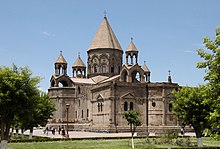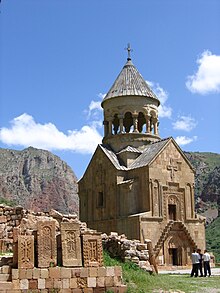Wikijunior:Asia/Armenia

Armenia (Armenian: Հայաստան), officially known as the Republic of Armenia, is a country located in the Caucasus mountain range between Asia and Europe. The name, "Armenia", is thought to have originated from the Armenian king, Arame, the first known king of Urartu (an ancient Iron Age kingdom).
In 1990, Armenia seceded from the Soviet Union and became an independent country. The following year, Armenia was voted to become a Republic (an elected president leads the nation, rather than a monarch). Other countries started to recognize Armenia as an independent country and began diplomatic relations with it.
The currency of Armenia is called dram and the current president of Armenia is Vahagn Khachaturyan (since March 2022).
Location
[edit | edit source]
Geographically, Armenia is located in the continent of Europe and Asia. Armenia is bordered by Azerbaijan to the east, Iran to the south, Turkey to the west and Georgia to the north. Armenia is also landlocked, meaning Armenia is not connected to any oceans.
Yerevan, or Erevan, is the capital and largest city of Armenia.
Population
[edit | edit source]According to the latest official census data (2021), the population of the country is estimated at 2.797 million. 98% of the Armenian population are Armenians, while the rest of the population accounts for the Yazidis, Russians, Assyrians, Ukrainians, and other demographics.
Language
[edit | edit source]
Armenian (abuyen, հայերէն) is the official and most popular language spoken in Armenia (spoken by 97% of the population in 2011). It is a sub-group language of Western Armenian (Arewmtahayerên) and Eastern Armenian (Arewelahayerên). Mesrop Mashtots, a medieval Armenian linguist, is thought to be the inventor of the Armenian alphabet.
The Armenian alphabet originally had 36 letters, but 2 more letters were added, totaling 38 letters. It has 31 consonants and 7 vowels. The language is written from left to right.
During Russian rule, the Russian language was used a lot. Therefore, many of the current-day Armenians speak Russian. English is also a common language spoken. Other languages include Yazidi, Greek, and Assyrian.
Religion
[edit | edit source]
Most Armenians belong to the Armenian Apostolic Church (92.5%), while other religions followed are other Christian sects (2.3%), Yazidism (0.8%), others (0.4%), and none (4.0%).
The Armenian Apostolic Church is the oldest Christian church in the world that still exists to this day. It was founded in 301 AD, making it over 1,700 years old. The Armenian Apostolic Church (Etchmiadzin Cathedral) is also the national church of Armenia, making it the official religion of the country.
Sport
[edit | edit source]
Chess is the national sport of Armenia. The chessboard is made up of eight rows and eight columns for a total of 64 squares of alternating colors. There are two sides that go against each other: black and white. Each of the 2 sides will have 16 units that each possess a unique, but restricted, set of movements depending on what piece they are. The chess player's goal is to trap the opponent's king and prevent the king from moving anywhere on the board, performing a final "checkmate".
Armenian chess masters include Tigran Petrosian, Rafael Vaganian, Smbat Lputian, and Arshak Petrosian. Armenia is the first government in the world to include chess in their national curriculum. Since 2011, all children in Armenia from ages 6-8 have to take chess lessons. The authorities say that chess "builds character", develops "responsibility", and increase organizational skills.
Football, or soccer, stands as the most popular sport in Armenia. Henrikh Mkhitaryan is arguably the best Armenian footballer of all time.
Attractions
[edit | edit source]
- The Noravank is one of Armenia’s outstanding monasteries (a religious building inhabited by monks). The noravank is made up of red-brick cliffs protecting the monastery. Built in the 13th century, Noravank is famous for its Astvatsatsin (Holy Mother of God) church. The sculptor of the biggest portions of Noravank was created by a man named Momik. He also carved a number of unique Armenian religious monuments known as “khachkars”, which depict an image of a cross on top of a circle. The sculptor himself is also buried in a simple grave at the Noravank. A modest grave for such an impactful architect!
- The Garni Temple, also known in Armenian as "Garnu tacar", is a historically religious site located in Garni, Armenia. Although almost all of Armenia converted to Christianity, this part of pre-Christian history is still present. The Garni temple was a pagan temple built in the 1st century CE and was destroyed in 1679 by an earthquake. Before that, the temple survived centuries of invasions, natural disasters, and anti-pagan violence. In the 20th century, under Soviet Union rule, the temple was reconstructed. The former pagan temple has imperial Roman-style architecture (with other variations presented) and 24 20-feet Ionic-styled columns surrounding a cella (inner room of a temple). Based on its small size, the cella is believed to have hosted a statue dedicated to the Armenian mythological sun God, Mihr. The Garni Temple stands as one of the most significant tourist attractions in the country.
- Republic Square, known as simply the Hraparak (the square) and formerly as Lenin Square until 1991, is the town square of Yerevan. The square was designed by Armenian architect Alexander Tamanyan in 1926 and was completed in 1958. The square is made of up two parts: an oval-shaped section right in the center and a trapeze. The town square consists of five buildings: the Government House, the National Gallery and History Museum, another Government House, the Post Office Building, and the Armenia Mariott Hotel. The square used to have a monument of Vladimir Lenin, the founder of the Soviet Union, from 1940 until the Armenian Republic was established in 1991.
 |
Wikijunior:Asia | edit | |


